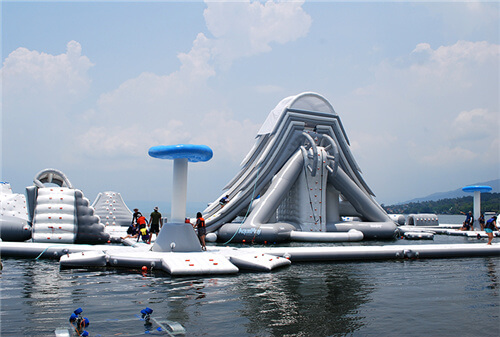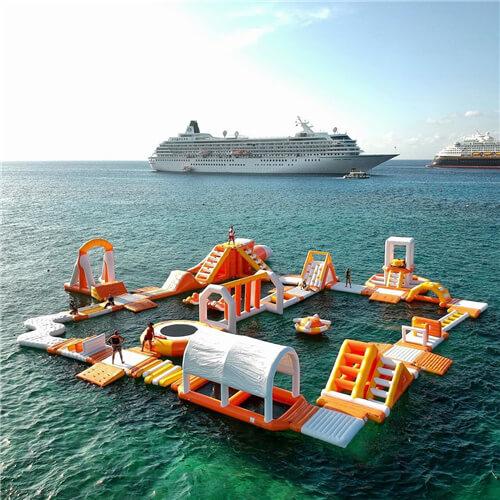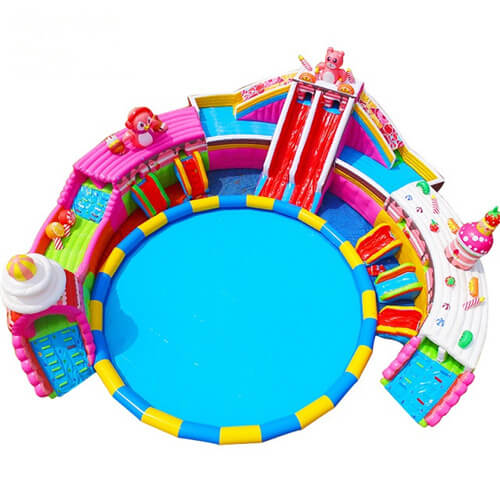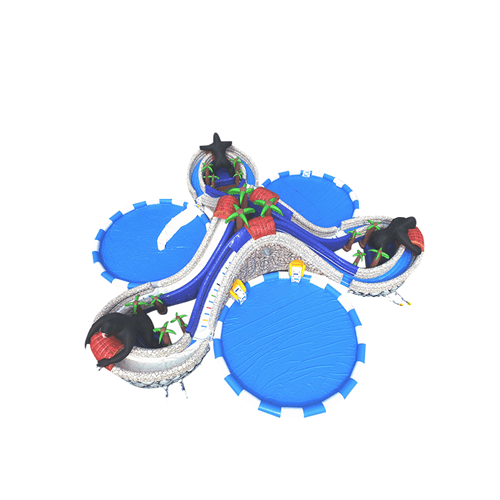Inflatable Water Park Business Guide: Start a Cool Summer Wealth Wave
I. Preliminary Market Research and Target Determination
- Geographical Location Analysis: Investigate local climate conditions, and areas with hot and long-lasting weather are more advantageous. Study the surrounding population density, age distribution, and consumption capacity, and give priority to areas with dense populations and a large number of families and children, such as near large urban residential areas and around popular tourist attractions, to ensure sufficient potential customer sources.
- Insight into competition: Investigate existing water entertainment projects in the same area, including traditional swimming pools, water parks, and other inflatable water parks, analyze their operating conditions, ticket prices, facility features, and service quality, and find out market gaps or differentiated competition directions, such as creating unique themes, adding parent-child interactive facilities, etc., to provide a basis for project positioning.
- Target customer lock-in: Clearly take children, teenagers, and their families as the main target customer groups, while considering expanding customer resources such as young groups, school groups, and corporate team building, and formulate corresponding marketing strategies and service plans based on the needs and consumption habits of different customer groups.
- Site selection and leasing

- Site requirements: Choose a site with convenient transportation, easy access, and sufficient parking space. The area depends on the scale of operation. Generally, a small park is 1,000-3,000 square meters, a medium-sized park is 3,000-5,000 square meters, and a large park is more than 5,000 square meters. The ground of the site should be flat, solid, and well-drained. There should be no safety hazards such as high-voltage wires and buildings around. It is best to have certain greening or sunshade facilities to enhance the experience of tourists.
- Lease negotiation: negotiate leasing matters with the site owner, strive for a longer lease term (preferably 3-5 years) to ensure business stability, negotiate prices reasonably, clarify the rent increase method and payment cycle, and stipulate the scope of use of the site, renovation authority, and the responsibilities and obligations of both parties in the contract, such as site maintenance responsibility, safety guarantee clauses, etc., to avoid subsequent disputes.
- Equipment procurement and installation
- Product selection: Select high-quality, environmentally friendly, and safe inflatable water park equipment, including various water slides, swimming pools, water barrier facilities, children’s water play sketches, etc., give priority to manufacturers with relevant certifications and good reputation, and make reasonable combinations according to the site area and target customer groups to ensure the diversity and fun of equipment and meet the needs of tourists of different ages, such as shallow water areas and small slides for young children, and exciting large slides and challenge levels for teenagers.
- Installation and commissioning: Hire a professional installation team to install the equipment according to the manufacturer’s guidance to ensure firmness and stability, and the connection parts are tightly sealed without the risk of air leakage and water leakage. After the installation is completed, a comprehensive commissioning inspection is carried out, including water and electricity systems, inflation pressure, slide slope and buffer, etc. Professionals are invited to conduct safety inspections. Only after obtaining a qualified report can the business be opened for operation. At the same time, the equipment is regularly maintained, such as cleaning and disinfection, inspection and repair, and replacement of vulnerable parts, to ensure that the equipment is always in good operating condition.

IV. Personnel recruitment and training
- Staffing: Recruit staff including ticket sellers, ticket inspectors, lifeguards, equipment maintenance personnel, cleaners, cashiers, etc. Determine the number of staff according to the scale of operation and business hours to ensure that each position has a clear division of labor and responsibility. For example, each position in a small park is equipped with 1-2 people, the number of personnel in medium-sized and above parks is appropriately increased and a shift system is set up to ensure smooth operation.
- Training and improvement: Comprehensive training for new employees, including service awareness and etiquette training to improve employees’ service attitude and communication skills; safety knowledge training, such as drowning first aid, equipment safety operating procedures, emergency evacuation plans, etc., to ensure that employees can respond to sudden safety incidents; job skills training, so that employees in various positions are familiar with work processes and operating specifications, such as ticket system operation, equipment maintenance points, cleaning and sanitation standards, etc., regular assessment and refresher training, and continuously improve employees’ business level and emergency response capabilities.

V. Marketing and Promotion Strategy
- Online Marketing: Build official websites and social media accounts to display park facilities, event information, ticket packages, etc., use search engine optimization (SEO), social media advertising, and online celebrity cooperation promotion to increase online exposure, regularly publish attractive graphic and video content, such as tourists’ wonderful moments, new facilities introductions, discount event information, etc., to attract potential customers to pay attention and interact, guide online booking and ticket purchase, and use online travel platforms (OTA) and parent-child activity platforms to expand sales channels and increase customer sources.
- Offline Promotion: Distribute flyers and post posters in surrounding communities, schools, shopping malls, supermarkets, etc., hold offline promotion activities, such as parent-child experience days, interactive games, and lucky draws, etc., to attract target customer groups to participate, establish cooperative relationships with schools, kindergartens, enterprises and other institutions, promote group tickets, group purchase discounts, organize study tours, team development and other projects, expand brand awareness and influence, attract more group customer resources, set up eye-catching signs and billboards around the park to attract the attention of passers-by and guide them to enter the park for consumption.
VI. Operation management and service optimization
1. Price setting: According to the local market consumption level, competitor prices and park operating costs, formulate a reasonable ticket price system, which can be divided into weekday tickets, weekend tickets, holiday tickets, children’s tickets, adult tickets, parent-child packages, family packages and other types, flexibly set early bird tickets, night tickets, member tickets, and other preferential prices to attract customer groups at different consumption levels, regularly evaluate and adjust ticket prices to ensure market competitiveness while ensuring profitability.
2. Daily operation: Formulate a complete operation management system, including business hours regulations, equipment opening and maintenance plans, staff scheduling system, safety inspection system, sanitation and cleaning system, etc., to ensure the orderly daily operation of the park, strengthen on-site management, promptly handle tourists’ inquiries, complaints and suggestions, create a good atmosphere for play, improve tourists’ satisfaction and reputation, regularly analyze operation data, such as passenger flow, income, tourist sources and consumption habits, etc., optimize business strategies and resource allocation based on data feedback, and improve operating efficiency.
- Value-added services: Set up dining areas, rest areas, shopping areas, etc. in the park, provide a variety of food, drinks, souvenirs and other commodities to meet the diverse needs of tourists, and provide supporting facilities such as changing rooms, showers, lockers, etc. to improve the convenience and comfort of tourists. Organize various theme activities, such as water music festivals, parent-child carnivals, summer foam parties, etc., to increase the fun and attraction of the park and improve the revisit rate and stickiness of tourists.

VII. Safety and risk management
- Safety measures: Set up solid fences around the park to prevent tourists from entering dangerous areas without authorization, set up obvious safety warning signs around the pool, slide entrances and other key locations to remind tourists to pay attention to safety matters, equip a sufficient number of lifeguards, distributed in various pool areas, to ensure that drowning and other safety accidents can be discovered and handled in time, regularly conduct first aid skills assessment and training for lifeguards to ensure their emergency rescue capabilities, conduct daily safety inspections on equipment, including inflation pressure, connection parts, electrical systems, etc., to promptly discover and eliminate safety hazards and ensure the safe operation of equipment.
- Risk response plan: formulate a comprehensive risk response plan, including measures for severe weather (such as heavy rain, strong wind, lightning, etc.), equipment failure handling process, crowding and trampling emergency plan, public health incident prevention and control plan, etc., regularly organize employees to conduct emergency drills, improve employees’ ability to respond to emergencies and coordination and cooperation, ensure that measures can be taken quickly and effectively in emergencies, protect the safety of tourists’ lives and property, and reduce operating risk losses.
The operation of inflatable water parks requires comprehensive consideration of the market, venues, equipment, personnel, marketing, operations, safety, and other aspects. Only by operating with heart and continuously optimizing and improving can we set off a wave of cool and joyful wealth in the hot summer and create a water entertainment project that is popular with tourists and profitable.
